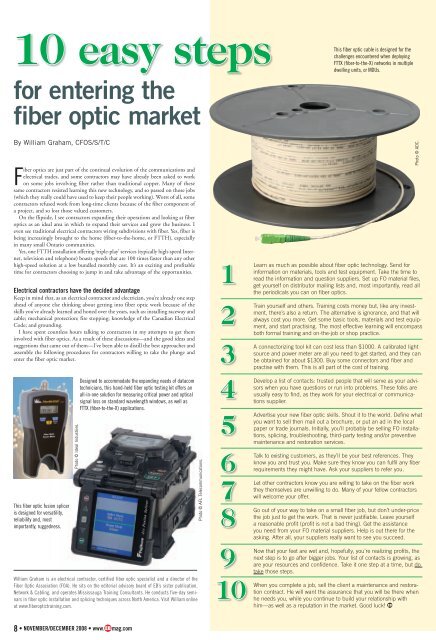Download - Electrical Business Magazine
Download - Electrical Business Magazine
Download - Electrical Business Magazine
You also want an ePaper? Increase the reach of your titles
YUMPU automatically turns print PDFs into web optimized ePapers that Google loves.
10 easy stepsThis fiber optic cable is designed for thechallenges encountered when deployingFTTX (fiber-to-the-X) networks in multipledwelling units, or MDUs.for entering thefiber optic marketBy William Graham, CFOS/S/T/CFiber optics are just part of the continual evolution of the communications andelectrical trades, and some contractors may have already been asked to workon some jobs involving fiber rather than traditional copper. Many of thesesame contractors resisted learning this new technology, and so passed on those jobs(which they really could have used to keep their people working). Worst of all, somecontractors refused work from long-time clients because of the fiber component ofa project, and so lost those valued customers.On the flipside, I see contractors expanding their operations and looking at fiberoptics as an ideal area in which to expand their services and grow the business. Ieven see traditional electrical contractors wiring subdivisions with fiber. Yes, fiber isbeing increasingly brought to the home (fiber-to-the-home, or FTTH), especiallyin many small Ontario communities.Yes, one FTTH installation offering ‘triple-play’ services (typically high-speed Internet,television and telephone) boasts speeds that are 100 times faster than any otherhigh-speed solution at a low bundled monthly cost. It’s an exciting and profitabletime for contractors choosing to jump in and take advantage of the opportunities.<strong>Electrical</strong> contractors have the decided advantageKeep in mind that, as an electrical contractor and electrician, you’re already one stepahead of anyone else thinking about getting into fiber optic work because of theskills you’ve already learned and honed over the years, such as: installing raceway andcable; mechanical protection; fire stopping; knowledge of the Canadian <strong>Electrical</strong>Code; and grounding.I have spent countless hours talking to contractors in my attempts to get theminvolved with fiber optics. As a result of these discussions—and the good ideas andsuggestions that came out of them—I’ve been able to distill the best approaches andassemble the following procedures for contractors willing to take the plunge andenter the fiber optic market.123Learn as much as possible about fiber optic technology. Send forinformation on materials, tools and test equipment. Take the time toread the information and question suppliers. Set up FO material files,get yourself on distributor mailing lists and, most importantly, read allthe periodicals you can on fiber optics.Train yourself and others. Training costs money but, like any investment,there’s also a return. The alternative is ignorance, and that willalways cost you more. Get some basic tools, materials and test equipment,and start practising. The most effective learning will encompassboth formal training and on-the-job or shop practice.A connectorizing tool kit can cost less than $1000. A calibrated lightsource and power meter are all you need to get started, and they canbe obtained for about $1300. Buy some connectors and fiber andpractise with them. This is all part of the cost of training.Photo © ADC.This fiber optic fusion spliceris designed for versatility,reliability and, mostimportantly, ruggedness.Photo © Ideal Industries.Designed to accommodate the expanding needs of datacomtechnicians, this hand-held fiber optic testing kit offers anall-in-one solution for measuring critical power and opticalsignal loss on standard wavelength windows, as well asFTTX (fiber-to-the-X) applications.Photo © AFL Telecommunications.45678Develop a list of contacts: trusted people that will serve as your advisorswhen you have questions or run into problems. These folks areusually easy to find, as they work for your electrical or communicationssupplier.Advertise your new fiber optic skills. Shout it to the world. Define whatyou want to sell then mail out a brochure, or put an ad in the localpaper or trade journals. Initially, you’ll probably be selling FO installations,splicing, troubleshooting, third-party testing and/or preventivemaintenance and restoration services.Talk to existing customers, as they’ll be your best references. Theyknow you and trust you. Make sure they know you can fulfil any fiberrequirements they might have. Ask your suppliers to refer you.Let other contractors know you are willing to take on the fiber workthey themselves are unwilling to do. Many of your fellow contractorswill welcome your offer.Go out of your way to take on a small fiber job, but don’t under-pricethe job just to get the work. That is never justifiable. Leave yourselfa reasonable profit (profit is not a bad thing). Get the assistanceyou need from your FO material suppliers. Help is out there for theasking. After all, your suppliers really want to see you succeed.William Graham is an electrical contractor, certified fiber optic specialist and a director of theFiber Optic Association (FOA). He sits on the editorial advisory board of EB’s sister publication,Network & Cabling, and operates Mississauga Training Consultants. He conducts five-day seminarsin fiber optic installation and splicing techniques across North America. Visit William onlineat www.fiberoptictraining.com.910Now that your feet are wet and, hopefully, you’re realizing profits, thenext step is to go after bigger jobs. Your list of contacts is growing, asare your resources and confidence. Take it one step at a time, but dotake those steps.When you complete a job, sell the client a maintenance and restorationcontract. He will want the assurance that you will be there whenhe needs you, while you continue to build your relationship withhim—as well as a reputation in the market. Good luck!8 • NOVEMBER/DECEMBER 2008 • www. mag.com
















